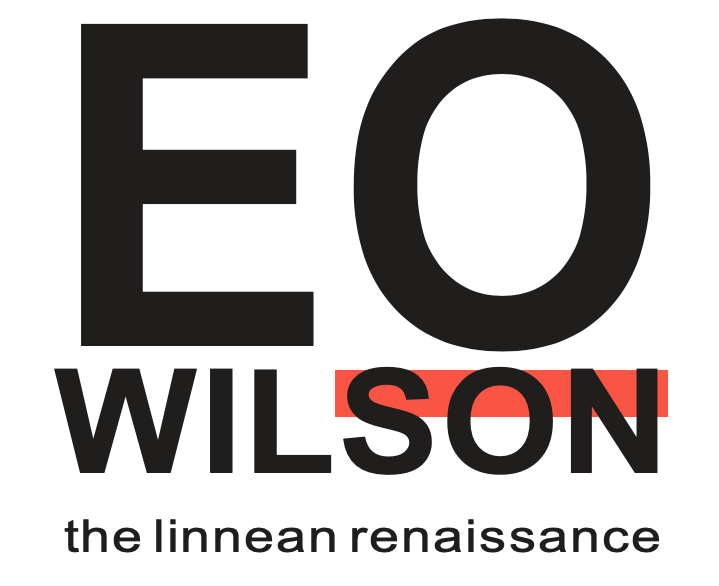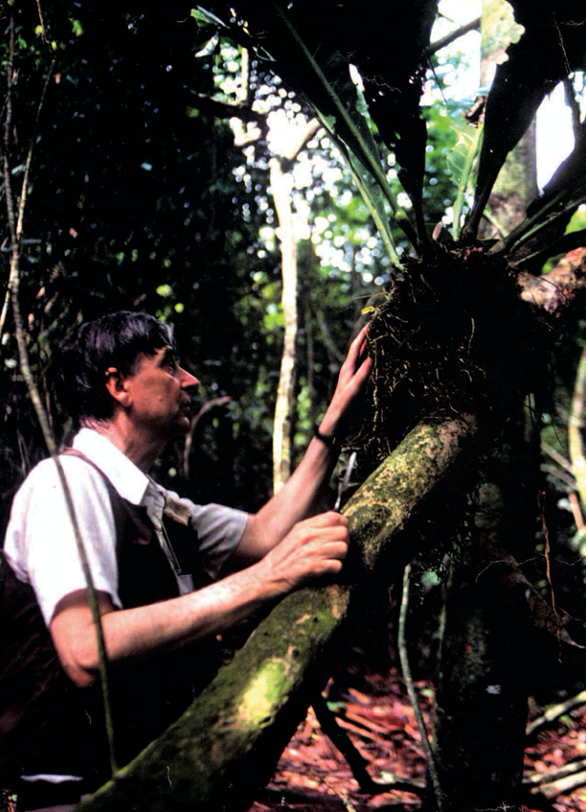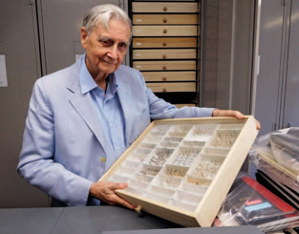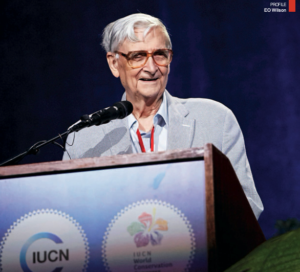A LOOK BACK: This 2017 article is posted by kind permission of the Geographical Magazine www.geographical.co.uk


by Nigel Winser
Nigel Winser meets the 87-year-old ‘father of biodiversity’ fresh from his keynote talk at the IUCN World Conservation Congress in Hawai‘i. His message is clear – we are not doing enough to safeguard nature for our own future, hence his plea for a new age of taxonomic fieldwork in every nook and cranny of our planet.


A large leatherback turtle sits in the foyer of the Harvard Museum of Natural History in leafy Cambridge, Massachusetts, serving as a sentinel for this home of biodiversity. You cannot help but pass it en route to the laboratory of Professor Edward Osborne Wilson (commonly cited as ‘EO’), a laboratory replete with the scent of museum naphthalene and ageing insects. At present, Wilson’s spotlessly tidy office is cluttered only by piles of his new book Half-Earth: Our Planet’s Fight for Life ready for signing. It’s far from the only book on show, however, and the room is full of nearly every biodiversity book ever published, including copies of his own 30 or so landmark titles that have shaped the thinking of scientists worldwide.
This is a personal pilgrimage, not only to meet Wilson, but to discuss his most ambitious goal to date: to persuade the political, business, and academic leaders of the world to dedicate half the surface of the Earth to nature – an act he believes is the only way to stave off the mass extinction of species, and the demise of our planet.
There is a warmth in Wilson, naturalist, scientist, author, theorist and now planetary campaigner. And at 87, he still cares about everyone he meets. He asks about my own experiences in the tropical forest world and I speak of the RGS’s biodiversity survey of the Gunung Mulu National Park, Sarawak in the late 1970s. Wilson immediately mentions the ant work by Barry Bolton from the British Natural History Museum, calling him one of the finest myrmecologists in the world.
Wilson’s own love of insects stems from his childhood. ‘When I was seven-years-old I had a microscope and I did the pond water thing,’ he recalls. ‘That was endlessly fascinating. You take a drop or two from a pond with a lot of life in and watch creatures that you couldn’t dream exist.’
SPECIES RISK
‘Come and see my ants.’ We cross the corridor into the Martin Wheeler Laboratory and Wilson’s much respected colleague, Stefan Cover, opens drawers with a selection of the million pinned and labelled ants, the finest collection in the world. It’s a collection of enormity, beauty and importance and is a glimpse into Wilson’s infinite world of ‘critters’ and the contribution they have made to his lifelong thesis about the diversity of life, the complexity of ecosystems and our understanding of planet Earth.
‘At the present rate we will finish the census of life sometime in the 23rd century. Don’t let anyone say that taxonomy was finished in the 19th century’
Last September the leaders of the conservation world met in Honolulu, Hawai‘i, for the 2016 World Conservation Congress. It was at this landmark gathering that Wilson threw down the gauntlet after the IUCN Director, Inger Anderson, invited him to give the opening address. ‘I am here to help speak for the little things that run the world,’ he began, reminding those present that we are in deeper trouble that we know. Yes, we know a great deal about resource depletion, pollution (especially in marine environments) and the number one risk – climate change. But it is the living part of the environment – our biosphere – that is in trouble: we don’t know how it works, and it is disappearing too fast.
‘How can we manage it when we have identified less than 20 per cent of the species on Earth,’ Wilson wonders? ‘Conservation organisations have their hands full with the vertebrates and the plants – and the forest species and so on, but now we must turn our attention to the full range of the ecosystem, to understand it and know it. That’s where the smaller creatures, the invertebrates, insects and even smaller organisms are, in a largely unknown and unexplored world.’
Wilson’s emphasis on the ‘smaller creatures’ underlines his greater philosophy. ‘If we just limit ourselves to the vertebrates – and in particular in the eyes of so much of the public, the celebrity vertebrates,’ he says, ‘the elephants and the lions and the tigers and the pandas and so on, which absolutely require and should have substantial amounts to support and keep them going – we will never be able to understand the ecosystems of the world well enough to describe them accurately, to find out what makes them work and determine those steps to keep them alive and sustainable. We must start to turn our attention to the little things on this Earth’.


Before our eyes, on a daily basis, biodiversity is declining. This precipitous free fall is at three tiers – the ecosystems (rivers, forests and coral reefs), the ten million species that compose the ecosystem, and the genes that prescribe the traits of the species that compose the ecosystem. ‘At the species level – the pivotal level in understanding the totality of the biosphere – extinction is approaching 1,000 times that prior to the global spread of humanity,’ Wilson warned the IUCN.
Wilson speaks frankly. Global taxonomists, field scientists and ecologists must be given more cash to find, classify, and map the eight million species still unknown to science. In parallel, and with increased urgency, we must unlock the hidden ecological secrets that determine a healthy planet. ‘At the present rate of research,’ he says, ‘we will finish the census of life sometime in the 23rd century. So don’t let anyone say that taxonomy and biogeography was finished in the 19th century.’
EARLY START
So where does an Alabama-born lover of nature, who lost an eye in a fishing accident at the age of seven get the lifelong courage and confidence to challenge Presidents and Prime Ministers?
His story begins in Mobile, Wilson’s ancestral town, and a summer camp in 1943 where, aged just 14, he became ‘Snake Wrangler in Chief’. As described in Letters to a Young Scientist, Wilson’s passion for the natural world (ants, snakes, and black widow spiders particularly) had caught the attention of the organisers of the local Boy Scout Camp. He was asked to be a Nature Counsellor while the seniors were at war.
Wilson was a fearless free spirit and loved being called on to deal with any snake found in the woods and deliver what he knew about the venomous and non-venomous types. ‘It was there, trying to tell about natural history – about more than I really knew – that I was seen as becoming a teacher, a professor as well as a natural historian, which was pleasant at the age of 14,’ he remembers This early break gave Wilson direction and confidence. His 20/10 vision prompted him to focus on the ‘little things’, as his reduced ability to observe mammals and birds led him to concentrate on insects.
So began his journey to put the word ‘biodiversity’ into the English language. A long and distinguished career as a naturalist, first at the University of Alabama, and then Harvard as an ant taxonomist. Wilson travelled on many expeditions collecting ant species in Cuba and Mexico, and then to the South Pacific including Australia, New Guinea, Fiji, New Caledonia and Sri Lanka. Between 1956 and 1996 his research led to his landmark theories of island biogeography, socio-biology and the role of biology in the human culture, which won his first Pulitzer Prize for On Human Nature in 1979.
Wilson’s work, papers, books and theories have made him a respected leader, working with IUCN and many international NGOs, including Earthwatch, to beat the drum about nature and this he continues to do with vigour. Today, as Professor Emeritus in the Harvard Museum of Comparative Zoology, and advisor to the EO Wilson Biodiversity Foundation, he plays the part of brave visionary, passionate about the importance of being close to nature at an early age and the urgency to engage a new generation of young environmentalists prepared to fight.
‘If you have the slightest interest in either becoming a scientist or having a career that will take you into the natural world for the rest of your life, then consider learning the natural history of a certain group of organisms that appeals to you,’ he advises. ‘If you like the idea of going out into the woods and into nature, then seize every opportunity to do that.’ Parents, students and teachers take note.
But how to take the first step? According to Wilson, the best investment to counter the current limpet addiction to the internet are ‘boots, a jam jar and a small inexpensive microscope.’ Increased exploration of the ‘small world’ of our gardens and local parks triggers curiosity and fun. ‘For a youngster, beginning as I did – its okay dealing with snakes, birds and butterflies. For an adolescent or even for a child that shows talent in this direction – these will suffice very well. But then as time goes along they are going to find the greatest opportunities are in some of the smallest things, such as mite and bacteria in the sea.’


BOOTS ON THE GROUND
The big question is how to shift gear about doing more for all the ‘critters’ – and importantly how we can get new funding and a new commitment for the taxonomic community, the museums and field centres of the world. Wilson’s vision is clear: ‘I call this the Linnean Renaissance, which has come back full circle to how modern biology began. This is the exploration of biodiversity and the Linnean enterprise that was so prominent and avidly pursued in the 19th century and especially in the first decade of the 20th century.’ Wilson feels
that observers and scientists generally made the huge mistake of assuming the 19th and 20th century enterprise was pretty much done. ‘Now, we need to re-inaugurate the age that was left unfinished and make that part of our new golden age,’ he says, ‘exploring our world as if we had just landed on a new planet and were discovering its life and sights: there would be no limits to finding every living thing on that planet.’
‘We need to explore our world as if we had just landed on a new planet and were discovering its life. There would be no limits to finding every living thing.’
His bold ideas are gaining traction. Wilson was given a standing ovation and a personal thank you by the President of IUCN in Honolulu. More importantly, through social media and the wider conservation world, his voice is being heard by a new generation of young scientists who, with moral courage, are determined to do more for the small things in life on land and in the sea, armed with new knowledge, technology and the belief to do what is right.


But time is not on our side. The race ahead is to ensure we keep 50 per cent of nature intact to give us the opportunity to study it before it goes. ‘In addition to the complete genome cataloguing of all known species and so on,’ he says, ‘we need to invest heavily in what I call “boots on the ground” – getting out there and finding it. We need a “Moonshot” for an audit of the biodiversity of the planet – and of species. Two, in fact. One to map the world and decide what areas need to be declared protected. And the other to learn and make available knowledge of all of the species and organisms that live on Earth. Ecosystem identifying is not enough.’
Wilson feels that as such an audit develops, there would be ‘species discovered and re-discovered and re-organized and be full of great interest.’ He sees this as then leading to an accompanying expansion of all kinds of biological research, right down to the level of molecular genetics. ‘In fact, there is already talk of a complete catalogue of the lettering of the genomes of all the world’s species,’ he says, before cautioning: ‘that’s a nice goal in words, but how are we going to do it? A genome of all the known species and make sense out of it? We have so far only seen and given as much as a scientific name to 20 per cent of the existing species on Earth – probably smaller when you add the micro-organisms.’
HEARING THE CALL
I leave Wilson and his team hoping the new leaders of the world will make such a pilgrimage to the Museum of Comparative Zoology to hear at first-hand the plea from the father of biodiversity. Passing the leatherback, with the ‘bug and boots’ message indelibly etched in my mind, I’m reminded that the world needs to work harder to support the ‘Linnean Renaissance’ to find and name the eight million critters before they disappear. This will only happen when more of us understand and respond to Wilson’s clarion call: ‘do no further harm to the biosphere’.
About the author: Nigel Winser
Kenyan born and trained as a life scientist at Westminster University, UK, Nigel has worked with pioneers in the field science community all his life, notably with the Royal Geographical Society and Earthwatch as a facilitator of geographical research programmes worldwide. Currently working with field scientists in the Sultanate of Oman and the Maasai Il N’gwesi Conservancy in north Kenya, Nigel enjoys being a mentor to young field scientists seeking purpose. Currently he advises a number of conservation NGO’s including Tusk Trust and the Nekton Mission, is the UK representative of the East African Wild Life Society, sits on the Editorial Advisory Board of the Geographical Magazine and a Honorary Conservation Fellow of the Zoological Society of London. Nigel has been awarded honorary doctorates from Westminster University and the Open University and is a lifelong Fellow of the Royal Geographical Society.

